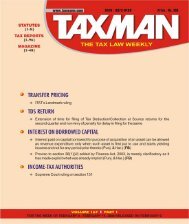CPT V24P7-Art1 (Content).pmd - Taxmann
CPT V24P7-Art1 (Content).pmd - Taxmann
CPT V24P7-Art1 (Content).pmd - Taxmann
You also want an ePaper? Increase the reach of your titles
YUMPU automatically turns print PDFs into web optimized ePapers that Google loves.
Direct Tax Laws<br />
the assessee. 33 Now even if the life and nonlife<br />
insurance businesses are separate and do<br />
not constitute separate departments of the same<br />
business, still the aforesaid provision can be<br />
effected. 34<br />
Under this rule the annual average of the<br />
surplus disclosed by the actuarial valuation 35<br />
made for the last inter-valuation period 36 pending<br />
before the commencement of the assessment<br />
year is to be taken as the basis of computation<br />
subject to certain adjustments. 37 It is not open<br />
to the department to make an addition to the<br />
surplus other than the adjustments specifically<br />
provided for in the Schedule, even if an item<br />
of the income escapes tax as a result of not<br />
being taken into account in making the actuarial<br />
valuation.<br />
The provision also stipulates that in case of<br />
any carry forward of losses or surplus, an<br />
adjustment for the surplus or deficit of an<br />
earlier inter-valuation period must be made to<br />
the surplus disclosed by actuarial valuation<br />
before the assessable annual average is<br />
calculated. 38<br />
5.1.2 RULE 2 39 - This rule stipulates that a<br />
surplus or deficit disclosed by the valuation<br />
for the relevant inter-valuation period includes<br />
the surplus or deficit of an earlier inter-valuation<br />
period. The same should be fragmented and<br />
the surplus or deficit from any previous intervaluation<br />
period must be excluded. 40<br />
For instance, if the actuarial valuation depicts<br />
a surplus of ` 24 lakhs which includes ` 4<br />
lakhs as surplus of the previous inter-valuation<br />
period which has been carried forward, the<br />
surplus to be actually taken into consideration<br />
shall be ` 20 lakhs arrived at after ignoring<br />
` 4 lakhs of the surplus carried forward from<br />
the previous inter-valuation period.<br />
For clarification, it was observed in LIC (supra)<br />
that when the assessee had taken over the<br />
assets and liabilities of the existing insurers,<br />
the refund received by the assessee in respect<br />
of excess tax paid by the predecessor companies<br />
must be deemed to be included in the previous<br />
664<br />
August 1 to 15, 2012 u TAXMANN’S CORPORATE PROFESSIONALS TODAY u Vol. 24 u 44<br />
inter-valuation period, rather than being included<br />
in the relevant inter-valuation period. 41<br />
It is pertinent to note that only the notional<br />
figure arrived at according to the valuation under<br />
rule 2 is to be taken as the basis of assessment<br />
and not the actual income of the relevant year,<br />
which might be more or less than the annual<br />
average of the last inter-valuation period 42 .<br />
5.1.3 RULE 4 43 - This rule specifies that when<br />
an assessment has been made under rule 2 on<br />
the basis of the annual average of surplus<br />
disclosed by actuarial valuation for an intervaluation<br />
period exceeding 12 months, no credit<br />
should be given in accordance with section<br />
199 for the tax deducted at source in the previous<br />
year, but credit should be given for annual<br />
average of tax deducted at source during such<br />
inter-valuation period. 44<br />
It has been clarified that this rule applies only<br />
to tax deducted at source and not when the<br />
tax is directly paid on assessment. 45<br />
METHOD OF CALCULATING THE PROFITS<br />
OF THE NON-LIFE INSURANCE<br />
BUSINESS<br />
6. Rule 5 46 of the First Schedule prescribes the<br />
method of calculating the income of a Non-<br />
Life Insurance Business for the purpose of tax<br />
assessment.<br />
It stipulates that the profits of non-life insurance<br />
businesses shall be taken to be the profits<br />
revealed by the annual accounts required to<br />
be furnished under the Insurance Act, 1938. 47<br />
It is pertinent to note that the figures in the<br />
accounts of the assessee drawn in accordance<br />
with the provisions of the First Schedule and<br />
satisfying the requirements of the Insurance<br />
Act are binding on the Assessing Officer. He<br />
has no general power to correct errors in accounts<br />
of the insurance business and undo any entry<br />
made therein. 48<br />
However, in terms of rule 5(a), if the profit<br />
has been arrived at after deducting any











![“FORM NO. 3CEB [See rule 10E] Report from an ... - Taxmann](https://img.yumpu.com/45480232/1/190x245/form-no-3ceb-see-rule-10e-report-from-an-taxmann.jpg?quality=85)





